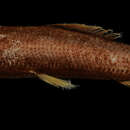en
names in breadcrumbs


View data on Catalog of Fishes here.
Vertebrae 40–43 [40–43] + 16–17 [15–18] =56–60 [55–59]. Maximum body depth 5.9–8.0 times in SL. Caudal peduncle depth 1.2–1.8 times in its length. Head length 3.9–5.1 times in SL. Eye diameter 3.9–5.5 times in head length. Teeth on jaws long, 4 fangs and 2 relatively large additional teeth present on praemaxilla. In comblike teeth row on maxillary bone 19–56 slant teeth, their number increasing with growth. One tooth on each side of vomer's head, a row of 8–12 teeth present on palatinum. Gill teeth 1214 [10–15]. The length of chin barbel is similar to head length or greater (0.4–0.9 times in head length at SL less than 100 mm and 0.6––1.3 times in head length in larger specimens), strongly decreases with growth (see Fig. 5), and terminates by the elongated and widened bulb.
Dorsal-fin rays 15–18 [15–17], anal-fin rays 16–19 [15–20], pectoral-fin rays 8–10 [8–10]. Pelvic fins located a short distance ahead of the level of dorsal fin origin. The beginning of anal fin is well behind the level of the end of dorsal fin base, separated from it by distance of 1.0–1.8 of eye diameter. Length of anal fin base is 0.8–1.0 times that of dorsal fin. Dorsal adipose fin starts above the 9–11th anal fin ray, ventral adipose fin under 18–20th photophore of VAV series.
Serial photophores medium-sized, inter-photophore spaces in large specimens 4–6 diameters of a single light organ. BR 19–22 [20–22]; IP 11–12 [10–12], PV 16––19 [15–19], VAV 24–29 [24–29], AC 9–12 [9–12], IC (61) 64–70 [62–70]; OV 17–19 [16–19], VAL 25–28 [25–27], OA 43–47 [(42) 43–48]. The photophores of IV series form a smooth arch of 2–3 slightly raised organs under the base of pectoral fin. In photophores of VA V and VAL series, last 5–6 photophores located above the base of anal fin. In AC series, the 1st photophore, usually, is slightly raised relatively to the following ones. 1–2 photophores (5th and/or 6th) raised in the middle part of AC series.
Postorbital organ in males twice as large, as in females, globular in shape, with the pointed anterior and widened posterior end, located under the middle (in females), or under the posterior part of the orbit (in males) (and sometimes exceeding orbit's margin), separated by wide space from the orbit. Oval skin hardening separates it from orbit. Dense aggregations of a luminescent tissue absent on the body. Small luminescent "scales" scattered on the upper surface of the head and dorsum till the beginning of dorsal fin. Sides of the trunk bear numerous additional photophores located in vertical lines.
Vertebrae 56–60. Serial photophores medium–sized, closely spaced. Photophores in IV series form a slight arch in front of pectoral fin base. First, as well as 5th and/or the 6th, photophores slightly raised in AC series. Photophores linear in the remaining series. Last 5–6 photophores in VAV and VAL series located above the anal fin base. IP 10–12, PV 15–19, VAV 24–29, AC 9–12, IC 62–70; OV 16–19, VAL 25–28, OA 42–48. Postorbital organ small, curved and globular, separated by wide space from the orbit. Wide skin hardening separates orbit and postorbital luminous organ which is positioned under its middle or posterior part. Dense aggregations of luminous tissue absent on the body, luminous "scales" present only on the upper part of the head and on dorsum. Dorsal-fin rays 15–18, anal-fin rays 15–20, pectoral-fin rays 8–0. Chin barbel with elongated terminal bulb, posteroventral part of which densely pigmented. Barbel length varies greatly. Pelvic fins located slightly ahead of the level of dorsal fin origin. Anal fin starts behind the level of the end of dorsal fin.
Temperate to tropical latitudes in the Atlantic; scattered records from the Indian and Pacific Oceans.
Mesopelagic.
Parin N, Borodulina O. 2000. Redescriptions and new data on distribution of six rare and poorly known species of the mesopelagic fish genus Astronesthes (Astronesthidae). Journal of Ichthyology 40(SUPP/1):15–30.
To about 170 mm.
44°25'N, 53°12'W, depth about 300 fathoms (stomach content).
Holotype: USNM 24645.